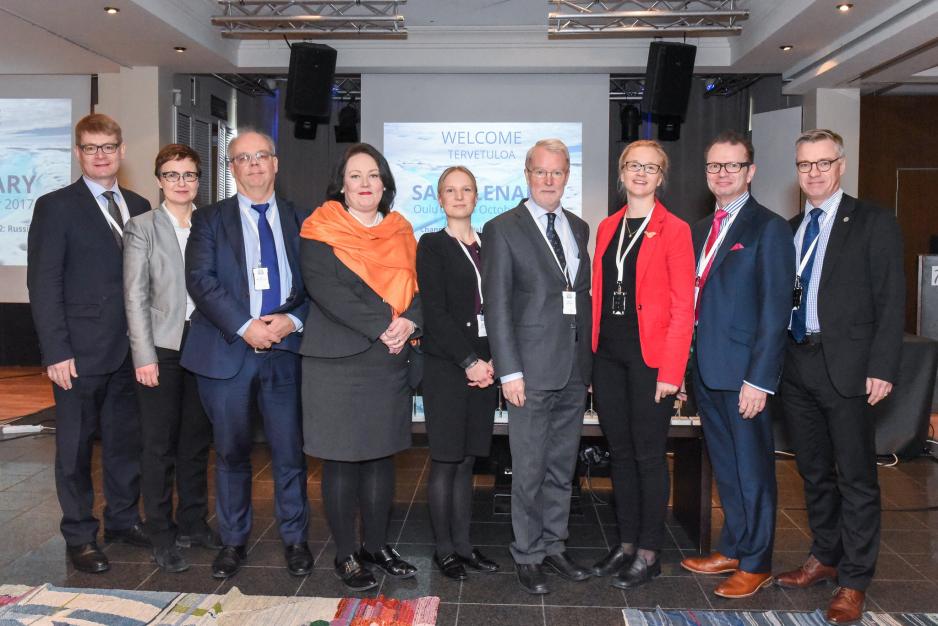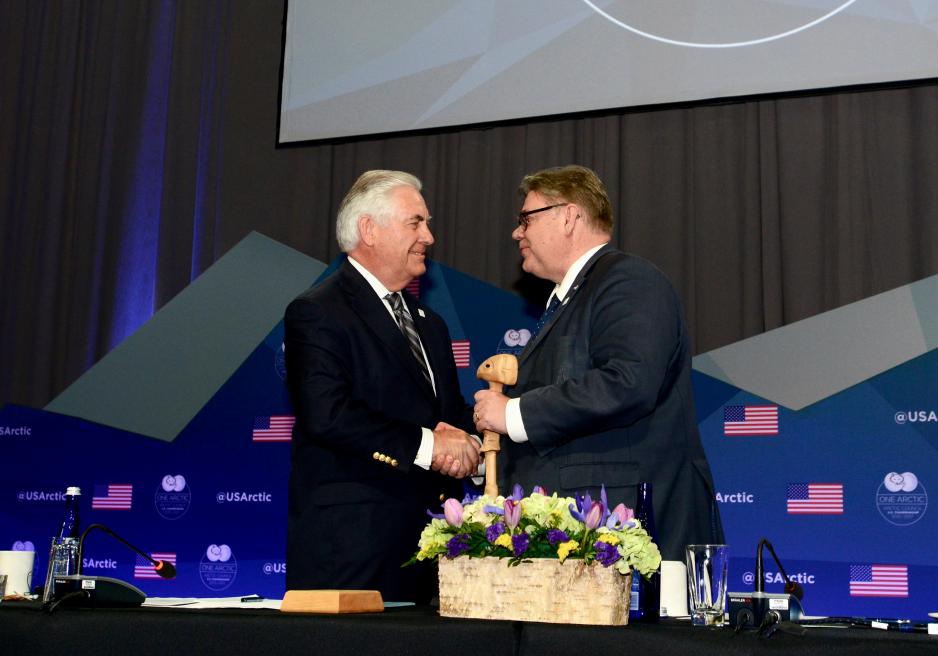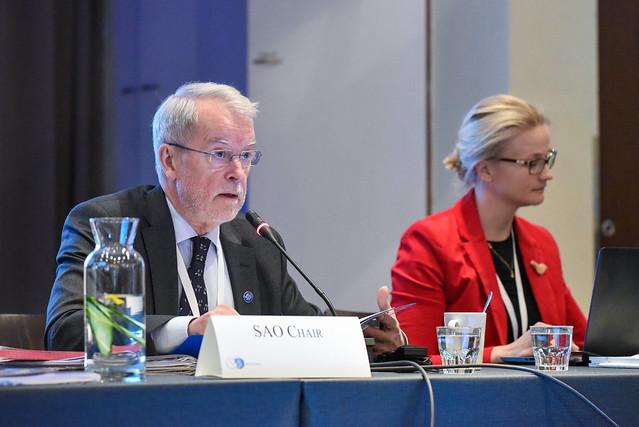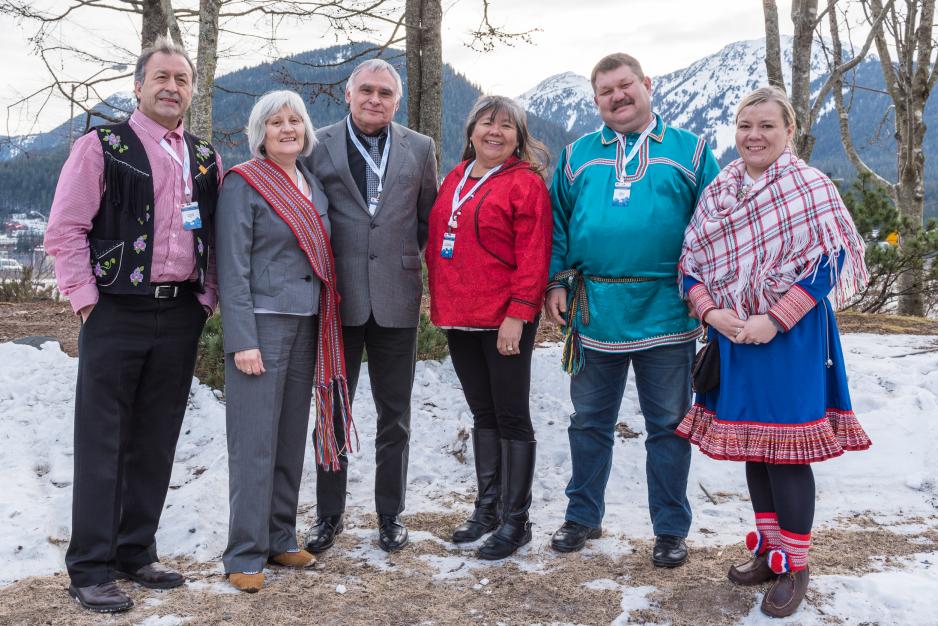What the Arctic Council has Achieved during the Two-year Finnish Chairmanship

Group photo with the Finnish Chairmanship team.
Photo credit: Arctic Council Secretariat / Linnea Nordström
Meteorological and oceanographic observations in the Arctic could very well be the greatest achievement during the Finnish Chairmanship in the Arctic Council. "I dare call it a breakthrough", says ambassador Aleksi Härkönen.
For two years, Finland has been leading the Arctic Council. It is time to look back at what it has accomplished during this time under the Finnish Foreign Minister Timo Soini and the Chair of the Senior Arctic Officials, Ambassador Aleksi Härkönen's leadership.
High North News has reached out to ask them what they think is Finland's greatest achievement during these past two years, and what they wish they could have accomplished but did not.
It was impossible to get these answers from the MFA Arctic team during this week. The summary below is based on the Arctic Council's own report on events and accomplishments during the Finnish Chairmanship and interviews given to arctic-council.org.
Arctic Council Ministerial Meeting in Rovaniemi
On May 7, Finland will host the 11th Arctic Council Ministerial Meeting in Rovaniemi.
Minister-level representatives from the eight Arctic States will convene to review and approve work completed
under the two-year Finnish Chairmanship to improve sustainable development and environmental protection in the Arctic.
Ministerial meetings take place biennially and mark the end of one Arctic Council Chairmanship and
the beginning of another.
Finland began its two-year term at the Ministerial meeting in Fairbanks, Alaska in 2017, resuming the Chairmanship from the United States.
At the upcoming meeting in Rovaniemi, Finland will pass the Chairmanship to Iceland.
Common solutions
Finland’s theme for its Arctic Council Chairmanship is “Exploring common solutions”. And the Finnish Chairmanship outlined four priority areas: environmental protection, meteorological cooperation, connectivity, and education.
This work is primarily carried out in six working groups: The Arctic Contaminants Action Program (ACAP), The Arctic Monitoring and Assessment Programme (AMAP), The Conservation of Arctic Flora and Fauna Working Group (CAFF), The Emergency Prevention, Preparedness and Response Working Group (EPPR), The Protection of the Arctic Marine Environment (PAME) Working Group and The Sustainable Development Working Group (SDWG).
Over the past two years, the Council’s subsidiary bodies – the Working Groups, Task Forces and Expert Groups – have engaged in more than 100 projects and initiatives.
Environmental protection
"With the annual average warming of the Arctic continuing to be more than twice the global average, implications for the Arctic environment and people living and working in the North are severe", is stated in the Arctic Councils own summary.

Secretary Tillerson Passes the Chairmanship Gavel to Finnish Foreign Minister Soini. (Photo: U.S. Department of State/Wikimedia Commons)
That also highlights the need of integrating Arctic issues in global climate frameworks: "The “Snow, Water, Ice and Permafrost in the Arctic” report developed by the Arctic Monitoring and Assessment Programme (AMAP) is one example. The assessment has fed into the UN Intergovernmental Panel on Climate Change (IPCC) Special Report on the impacts of global warming of 1.5 °C above preindustrial levels and is currently being used in the preparation of the IPCC Special Report on the Ocean and Cryosphere in a Changing Climate".
This was also pointed out by NUPI-researcher Elana Wilson Rowe in an interview with High North News earlier this week. Although she thinks it is unlikely that the problem of global climate change can be solved in the Arctic Council alone, she hopes the Arctic states manage to reach agreement on a statement about climate in their joint declaration.
Norway’s Senior Arctic Official, Bård Ivar Svendsen, admits that the Arctic Council has some difficulties on finding a language all the member states can agree on in a joint declaration.
In an interview posted on arctic-council.org, Härkönen is asked about the Ministerial Declaration: "If finding consensus requires more time, are the Senior Arctic Officials and Permanent Participants prepared to take last minute decisions?"
If necessary, we will have to make the last moves immediately before the Ministerial.
He answers: "We are prepared to do that as well. We don’t expect that new questions will be raised, or previous decisions will be reopened before the Ministerial. However, there are open questions that we know will be difficult and we try to solve them well in advance. But if necessary, we will have to make the last moves immediately before the Ministerial – nothing extraordinary in negotiations within international organizations".
Meteorological success
During the Finnish Chairmanship, the Arctic Council initiated a close collaboration with the World Meteorological Organization and national meteorological institutes. This cooperation enhances meteorological and oceanographic observations in the Arctic, which in turn will improve services and forecasting – benefitting people in the High North and lower latitudes, polar operators, businesses, and researchers, the report states.
This is highlighted as one of the biggest accomplishments of the Finnish Chairmanship.

Aleksi Härkönen Aleksi Härkönen, Chair of the Senior Arctic Officials
In an interview on arctic-council.org in late January, Aleksi Härkönen emphasized the meteorological cooperation as one of the top priorities: "I dare call it a breakthrough already now. In March 2018, we brought together both the Arctic Council and meteorological community in Levi, one of our ski resorts in Northern Finland. It was quite a week with the Senior Arctic Officials’ meeting and an Arctic Meteorological summit, which we hosted together with the World Meteorological Organization, the Finnish Meteorological Institute, and other national institutes", he said.
And just a few days ago, he added: "When talking about climate change, then meteorological cooperation is a common solution as the scientific work strengthens our understanding of climate issues, phenomena, and change. We don’t have to agree to disagree if there is climate change or not. We can base our understanding on solid data through meteorological research and other scientific fields. The Arctic Council should continue to make necessary recommendations, that is more important than ever".
Pollution
Besides the emphasis on measures to mitigate and adapt to climate change, Finland placed the prevention of pollution high on its Chairmanship agenda.
We don’t have to agree to disagree if there is climate change or not. We can base our understanding on solid data.
Over the past two years, the Council’s Working Groups have furthered the knowledge on the effects of pollutants and worked on projects to mitigate the impacts on Arctic inhabitants.
AMAP has assessed how pollutants and chemicals affect Arctic wildlife and fish, which in turn has implications for food security. ACAP continued to look for solutions on how to reduce releases of short-lived climate pollutants, actively engaging with indigenous peoples and local communities.
The Working Groups have contributed substantially to both the Minamata Convention on Mercury and the Stockholm Convention on Persistent Organic Pollutants.
In addition to its work on reducing emissions, ACAP’s Circumpolar Local Environment Observer Network (CLEO) has progressed significantly over the past two years. Close to 3000 local observers across the Arctic report on the changes they witness in weather, landscapes and seascapes.
Protection of the seas
While new sea routes may bring prosperity to the region, increasing accessibility of the High North also bears risks for Arctic inhabitants and ecosystems. Over the past years, marine litter has emerged as one of the most pervasive problems affecting the marine environment globally. The Arctic is no exception.
"The Protection of Arctic Marine Environment (PAME) Working Group has completed a “Desktop Study on Marine Litter in the Arctic” during the Finnish Chairmanship. This is the first circumpolar compilation of marine litter reports and
studies and a step towards evaluating the scope of marine litter in the Arctic – and what can be done to tackle the issue", the summary of the Finnish Chairmanship states.
This is the first circumpolar compilation of marine litter reports and studies and a step towards evaluating the scope of marine litter in the Arctic – and what can be done to tackle the issue.
Also, according to the 2018 “Arctic Ocean Acidification Assessment” by the Arctic Monitoring and Assessment Programme, arctic marine waters are experiencing widespread and rapid acidification with varying effects on Arctic marine life. One of the most staggering finding is that ocean acidification greatly increases the risk of fishery collapse – with potentially severe effects on the fishing industry.
A Task Force on Arctic Marine Cooperation has continued its work during the Finnish Chairmanship. The Task Force has looked at how Arctic States could better coordinate their work on marine issues and found that the Senior Arctic Officials, the government representatives from the Arctic States, should play a central role, according to the summary.
Involving indigenous people
The Arctic Council has worked on stepping up its commitment to involve and partner with indigenous peoples represented by the Permanent Participants. Already during the previous Chairmanship, held by the United States, PAME released a report on “Meaningful Engagement of Indigenous Peoples and Local Communities in Marine Activities” (MEMA).
"During the Finnish Chairmanship PAME has continued its efforts and worked on a second part of the MEMA report, which will guide the Council’s Working Groups, Task Forces and Expert Groups on how to involve the Permanent Participants, and Arctic indigenous peoples they represent, in their projects and assessments", the report states.
Connecting people
Over the past two years, the Arctic Council and its Working Groups thus have explored how economic and social progress could go hand in hand with cultural self-expression of Arctic communities. Two of the priority themes directly affect living and working conditions in the High North: Connectivity and education.
“Electronic communication services considerably improve both the safety and the quality of life for everybody who lives in, works in or visits the Arctic – be it indigenous peoples, local communities and businesses, tourists, or researchers. We therefore put it high on our agenda to improve connectivity in the Arctic”, said ambassador Härkönen in an interview given to the Arctic Council in late March this year.
The Fairbanks Declaration, which guides the Finnish Chairmanship during its two-year term, states “the importance of furthering efforts to improve telecommunications in the Arctic as a means to support thriving Arctic communities”.
In this declaration, Ministers of the eight Arctic States decided to establish a Task Force on Improved Connectivity in the Arctic (TFICA), which would compare the needs of those who live, operate, and work in the Arctic with available infrastructure.
"Their good news: Opportunities for improved connectivity are on the horizon, increasing connectivity, speed and coverage throughout the Arctic" states the summary.
“Connectivity requirements across the Arctic vary greatly as does their required scale, ranging from local to pan-Arctic. There is no ‘one size fits all’ solution. But each of the ongoing projects has the potential to dramatically increase connectivity, speed and improve coverage throughout the Arctic”, says Marjukka Vihavainen-Pitkänen, Co-Chair of TFICA.
The Task Force will present its findings at the Ministerial meeting in Rovaniemi.
It is vital for the Council to consolidate cooperation among the Arctic States in these changing circumstances. Something the Finnish Chairmanship has accomplished to do.
Finland and the United States also cooperated with WWF to host the first Arctic Youth Summit, which
was held in conjunction with the Arctic Biodiversity Congress in October 2018.
Arctic Cooperation
The summary acknowledges that the Arctic is changing and so is the political reality the Arctic Council operates within: "It is vital for the Council to consolidate cooperation among the Arctic States in these changing circumstances. Something the Finnish Chairmanship has accomplished to do".
The report states that despite global tensions, representatives of all eight Arctic States have continued to come together to discuss joint visions for protecting the Arctic environment, fostering sustainable development and maintaining peace and stability in the region: "Cooperation in the High North thus has remained largely unaffected by tensions arising outside the Arctic".
Over the past two years, the Council’s subsidiary bodies – the Working Groups, Task Forces and Expert Groups – have engaged in more than 100 projects and initiatives.

Heads of Delegation for the six Indigenous Permanent Participant organizations at the Senior Arctic Officials' meeting in Juneau, 2017 (Arctic Council Secretariat / Linnea Nordström)
The active participation of the Permanent Participants is also one of the key features of the Arctic Council. In November 2018, the Indigenous Peoples’ Secretariat (IPS) organized an international introductory course together with the Russian Association of Indigenous Peoples of the North (RAIPON), and the University of the Arctic EALÁT Institute on “the Arctic Council and the role of Permanent Participants” in Moscow, Russia.
"The event gathered more than 60 indigenous leaders and youth from across the Russian Federation to learn more about the Arctic Council", according to the summary of the Finnish Chairmanship.
In addition to the Permanent Participants, Arctic Council Observers play an important role, especially in areas where issues arise or affect regions outside of the Arctic. Reducing black carbon and methane emissions and their negative impacts on people and ecosystems of the North, for example, is dependent on the active participation that Observer states have shown in the Expert Group on Black Carbon and Methane.
Thank you
Ambassador Aleksi Härkönen, Chair of the Senior Arctic Officials, sums up an interview on arctic-council.org with a thank you:
"I would like to say that if we will conclude this Chairmanship successfully, it is because we have had a very good cooperation within Finland, with the Sami representatives, the cities, the Arctic Economic Council, and other stakeholders. We also have had a very good cooperation with our international partners and this definitely includes the Arctic Council Secretariat".
If we will conclude this Chairmanship successfully, it is because we have had a very good cooperation within Finland, with the Sami representatives, the cities, the Arctic Economic Council, and other stakeholders.

